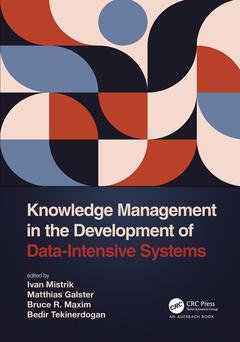Description
Knowledge Management in the Development of Data-Intensive Systems
Coordinators: Mistrik Ivan, Galster Matthias, Maxim Bruce R., Tekinerdogan Bedir
Language: English
Subjects for Knowledge Management in the Development of...:
Keywords
Data Intensive Systems; Business process data; Data Set; Flexible environments; Software Intensive System; Data-intensive software systems; Cloud Computing; Confront developing; Cloud Providers; Knowledge management; Machine Learning; Software Systems; Software; Reference Architectures; Knowledge Acquisition; Software Artifacts; Smart Home; Big Data; Big Data Systems; Machine Learning Algorithms; Deep Learning Algorithms; Technical Debt; Product Line Architectures; Virtual Screening Workflow; Natural Language Processing; Decision Forest; Augmented Analytics; Big Data Applications; Cloud Monitoring; Virtual Screening
Publication date: 09-2023
· 17.8x25.4 cm · Paperback
Publication date: 06-2021
· 17.8x25.4 cm · Hardback
Description
/li>Contents
/li>Biography
/li>
Data-intensive systems are software applications that process and generate Big Data. Data-intensive systems support the use of large amounts of data strategically and efficiently to provide intelligence. For example, examining industrial sensor data or business process data can enhance production, guide proactive improvements of development processes, or optimize supply chain systems. Designing data-intensive software systems is difficult because distribution of knowledge across stakeholders creates a symmetry of ignorance, because a shared vision of the future requires the development of new knowledge that extends and synthesizes existing knowledge.
Knowledge Management in the Development of Data-Intensive Systems addresses new challenges arising from knowledge management in the development of data-intensive software systems. These challenges concern requirements, architectural design, detailed design, implementation and maintenance. The book covers the current state and future directions of knowledge management in development of data-intensive software systems. The book features both academic and industrial contributions which discuss the role software engineering can play for addressing challenges that confront developing, maintaining and evolving systems;data-intensive software systems of cloud and mobile services; and the scalability requirements they imply. The book features software engineering approaches that can efficiently deal with data-intensive systems as well as applications and use cases benefiting from data-intensive systems.
Providing a comprehensive reference on the notion of data-intensive systems from a technical and non-technical perspective, the book focuses uniquely on software engineering and knowledge management in the design and maintenance of data-intensive systems. The book covers constructing, deploying, and maintaining high quality software products and software engineering in and for dynamic and flexible environments. This book provides a holistic guide for those who need to understand the impact of variability on all aspects of the software life cycle. It leverages practical experience and evidence to look ahead at the challenges faced by organizations in a fast-moving world with increasingly fast-changing customer requirements and expectations.
Chapter 1: Data-Intensive Systems, Knowledge Management, and Software Engineering. PART I: CONCEPTS AND MODELS. Chapter 2: Software Artifact Traceability in Big Data Systems. Chapter 3: Architecting Software Model Management and Analytics Framework. Chapter 4: Variability in Data-Intensive Systems from an Architecture Perspective. PART II: KNOWLEDGE DISCOVERY AND MANAGEMENT. Chapter 5: Knowledge Management via Human-Centric, Domain-Specific Visual Languages for Data-Intensive Software Systems. Chapter 6: Augmented Analytics for Datamining: A Formal Framework and Methodology. Chapter 7: Mining and Managing Big Data Refactoring for Design Improvement. Are We There Yet?. Chapter 8: Knowledge Discovery in Systems-of-Systems: Observations and Trends. PART III: CLOUD SERVICES FOR DATA-INTENSIVE SYSTEMS. Chapter 9: The Challenging Landscape of Cloud-Monitoring. Chapter 10: Machine Learning as a Service for Software Application Categorization. Chapter 11: Workflow-as-a-Service Cloud Platform and Deployment of Bioinformatics Workflow Applications. PART IV: CASE STUDIES. Chapter 12: Instrumentation and Control for Real Time Decisions in Software Applications: Findings and Knowledge Management Considerations. Chapter 13: Industrial Evaluation of An Architectural Assumption Documentation Tool: A Case Study.
Ivan Mistrík is a researcher in software-intensive systems engineering. He is a computer scientist who is interested in system and software engineering and in system and software architecture, in particular: life cycle system/software engineering, requirements engineering, relating software requirements and architectures, knowledge management in software development, rationale-based software development, aligning enterprise/system/software architectures, value-based software engineering, agile software architectures, and collaborative system/software engineering. He has more than forty years’ experience in the field of computer systems engineering as an information systems developer, R&D leader, SE/SA research analyst, educator in computer sciences, and ICT management consultant.
Bruce R. Maxim has worked as a software engineer, project manager, professor, author, and consultant for more than 40 years. His research interests include software engineering, user experience design, game development, AR/VR/XR, social media, artificial intelligence, and computer science education. Bruce Maxim is professor of computer and information science and collegiate professor of engineering at the University of Michigan—Dearborn.
Matthias Galster is an Associate Professor in the Department of Computer Science and Software Engineering at the University of Canterbury in Christchurch, New Zealand. Previously he received a PhD in Software Engineering. His current work aims at improving the way we develop high-quality software, with a focus on software requirements engineering, software architecture, development processes and practices, and empirical software engineering.
Bedir Tekinerdogan is a full professor and chair of the Information Technology group at Wageningen University in The Netherlands. He received his PhD degree in Computer Science from the University of Twente, The Netherlands. He has more than 25 years of




